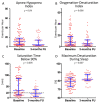Prevalence of Sleep Disordered Breathing in Patients with Primary Mitral Regurgitation Undergoing Mitral Valve Surgery
- PMID: 34068674
- PMCID: PMC8126064
- DOI: 10.3390/jcm10092039
Prevalence of Sleep Disordered Breathing in Patients with Primary Mitral Regurgitation Undergoing Mitral Valve Surgery
Abstract
Background: Sleep disordered breathing (SDB) is a frequent comorbidity in cardiac disease patients. Nevertheless, the prevalence and relationship between SDB and severe primary mitral regurgitation (PMR) has not been well investigated to date.
Methods: A cohort of 121 patients with significant PMR undergoing mitral valve surgery were prospectively enrolled and received a cardiorespiratory single night polygraphy screening using ApneaLink before surgery. Eighty-two of them underwent a follow-up examination including a follow-up single-night sleep study 3 months after surgery.
Results: The mean age of patients was 65.3 ± 12.0 years. Sixty patients (49.6%) were female. The mean EuroSCORE II was 2.5 ± 2.4%. Initially, 91 (75.2%) patients presented with SDB, among whom 50.4% (46 patients, 38.0% of total cohort) were classified as moderate to severe. These patients tended to require significantly longer postoperative intensive care and mechanical ventilation. Among the 82 patients who completed follow-up exams, mitral valve surgery led to a significant reduction in relevant SDB (20.7%). The apnea-hypopnea index (from 11/h [4;18] to 4/h [3;14] (p = 0.04)), the oxygenation-desaturation index (from 8/h [3;18] to 5/h [3;12] (p = 0.008)) as well as the saturation time below 90% (from 32 min [13;86] to 18 min [5;36] (p = 0.005)), were all shown to be improved significantly.
Conclusion: The prevalence of SDB is very high in patients with severe primary mitral regurgitation and may contribute to postoperative complications and prolonged intensive care. A significantly reduced but still high prevalence of SDB was observed 3 months after mitral valve surgery, highlighting the bidirectional relationship between SDB and heart failure.
Keywords: mitral regurgitation; mitral valve surgery; sleep disordered breathing.
Conflict of interest statement
The authors declare no conflict of interest.
Figures



References
-
- Oldenburg O., Lamp B., Faber L., Teschler H., Horstkotte D., Topfer V. Sleep-disordered breathing in patients with symptomatic heart failure: A contemporary study of prevalence in and characteristics of 700 patients. Eur. J. Heart Fail. 2007;9:251–257. doi: 10.1016/j.ejheart.2006.08.003. - DOI - PubMed
-
- Jilek C., Krenn M., Sebah D., Obermeier R., Braune A., Kehl V., Schroll S., Montalvan S., Riegger G.A., Pfeifer M., et al. Prognostic impact of sleep disordered breathing and its treatment in heart failure: An observational study. Eur. J. Heart Fail. 2011;13:68–75. doi: 10.1093/eurjhf/hfq183. - DOI - PubMed
Grants and funding
LinkOut - more resources
Full Text Sources

